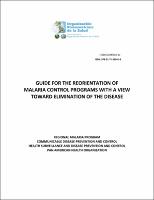Guide for the reorientation of malaria control programs with a view toward elimination of the disease
Date
2011ISBN
978‐92‐75‐33041‐8
Metadata
Show full item recordAbstract
[Introduction]. In recent years the number of malaria cases has fallen substantially in several of the 21 endemic countries in the Americas. According to information reported to the Pan American Health Organization by its Member States in 2009, during the period in question there were no cases of Plasmodium falciparum at all in some countries and only low numbers of focalized cases in others. P. vivax also declined considerably in a number of countries, where slide positivity rates were lower than 1% and incidence rates reported by first- and second-level administrative units (municipalities, cantons, or districts) were much lower than 1 case per 1,000 population. When it comes to shifting the programs’ emphasis from controlling malaria to eliminating it, WHO proposes that the first program reorientation should be initiated when the rate of positive slides (or rapid tests) falls below 5% based on information that is representative of the entire endemic area. However, this rule of thumb may not apply in all the countries: what is essential is that the disease burden is sufficiently low to allow for individual monitoring of each malaria patient. This is the fundamental change that needs to take place in those malaria programs that have the potential to eliminate the disease. A program’s ability to achieve this status will depend on the capacity of the health system, access to services, communication facilities, infrastructure, and availability of transportation. It would be very difficult for a program to meet the criteria for elimination with a slide positivity rate of more than 5% or an annual incidence of more than 5 cases per 1,000 inhabitants...
Collections
Related items
Showing items related by title, author, creator and subject.
-
Pan American Health Organization (PAHOUnited StatesWashington, D.C, 2016)In 1954, the countries in the Americas made the trail- blazing decision to adopt malaria eradication as a program with the Pan American Sanitary Bureau as the coordinating unit. It was a year later when the Global Program ...
-
Pan American Health Organization (PAHOUnited StatesWashington, D.C., 2016)In 1954, the countries in the Americas made the trail- blazing decision to adopt malaria eradication as a program with the Pan American Sanitary Bureau as the coordinating unit. It was a year later when the Global Program ...
-
Pan American Health Organization; Communicable Diseases and Environmental Determinants of Health (CDE) (PAHOUnited StatesWashington, D.C., 2023-02-06)PAHO Disease Elimination Initiative: A Policy for an Integrated Sustainable Approach to Communicable Diseases in the Americas aims to end the burden of communicable diseases for future generations. This initiative includes ...




